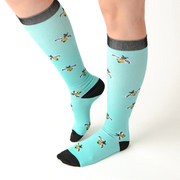The occurrence of deep vein thrombosis (DVT) can have serious consequences if it travels to your lungs and blocks an artery. Blood clots usually form in your legs especially in your lower legs. But they can form anywhere in your body.
DVT symptoms include the skin feeling warm when you touch it, swelling, tenderness or pain. While anyone is at risk of developing DVT, you are at greater risk following a traumatic event or an operation. Being a smoker and overweight are other risk factors.
Because of the seriousness of DVT, your doctor may recommend wearing compression stockings. They work by reducing swelling and improving the blood flow to your heart and lungs.
How compression stockings work
Compression stockings are just like tights or pantyhose except they have a different function and are made from a different material. You wear pantyhose to protect your legs and as part of an outfit. But compression stockings are an elasticised material made to fit snugly around your ankle area and less tightly further up your caves and thighs.
They create pressure to move the blood up your legs so it can circulate freely to your heart. They also reduce any pain and swelling. Doctors recommend medical compression stockings to prevent DVT to stop your blood pooling and clotting around your ankles.
Causes and risks for developing deep vein thrombosis
In general, a combination of two of the following underlying conditions can cause a DVT to form:
- Damage, irritation or inflammation to the lining surface of your veins.
- The sluggish or slow flow of blood through a major vein.
- A predisposition to your blood clotting quickly which can be hereditary in some cases.
There are many risk factors that can lead to developing a blood clot. These are cumulative meaning the more risk factors you have, the greater the risk of blood clots.
DVT risk factors include:
- Being over the age of 40.
- A history of high blood pressure.
- Carrying too much weight.
- Smoking.
- High levels of estrogen such as taking the pill or when you are pregnant.
- Bedridden or lack of mobility.
- Sitting for long periods of time such as while traveling.
- A previous history of DVT or superficial venous thrombosis.
- A major physical trauma or an operation especially orthopaedic surgery.
- Living a sedentary life.
- Varicose and spider veins.
- Stroke or heart attack.
- Some types of cancer.
Treating deep vein thrombosis
To treat DVT, your doctor will prescribe an anticoagulant drug and wearing medical compression stockings. Taking the drugs and wearing compression socks will allow rapidly decrease the symptoms so you can move around normally. And the treatment can last for up to a couple of months.
Compression stockings apply graduated external pressure to your leg to reduce the pressure on the veins in your legs. The stockings are like an additional layer of muscle. They gently squeeze the walls of your stretched veins together to close the valves. This reduces the size of the vein and restores your circulation to normal.
Tips for preventing DVT
There are many things you can do to prevent DVT if your lifestyle or an operation puts you at high risk of DVT. These include:
- Checking with you doctor if you need compression stocking when bedridden in hospital.
- Getting up and moving around at least once an hour when flying for more than four hours.
- Staying active by exercising regularly.
- Trying not to stay still for too long.
- When driving long distances make sure you stop every two hours to move around.
- Stop smoking.
- Eating a healthy, well-balanced diet.
- Losing weight if you are overweight.
- Asking your doctor about the risk of DVT when undergoing hormone replacement therapy or taking the pill, and during and after pregnancy.
- Wearing loose fitting clothes and stay hydrated when travelling.
- When you cannot move around, move your feet in circles and do heel toe exercise to keep you blood circulating.
- Wear the right type of compression stockings for the situation.
Takeaway
Compression stockings are good for preventing and treating DVT. But it is important you use the right level of compression for the situation. Do not use medical grade compression stockings unless prescribed or advised by your medical professional or they may cause unintended problems.
 Active Compression
Active Compression
 Plain Compression Socks
Plain Compression Socks
 Colourful Compression
Colourful Compression

